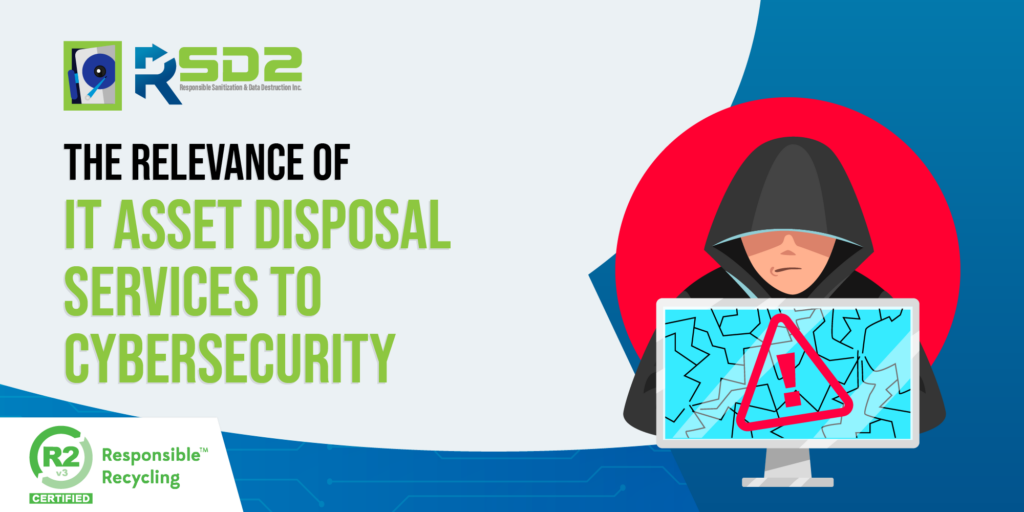The Relevance of IT Asset Disposal Services to Cybersecurity

Beyond just firewalls and antivirus software. The digital world poses a serious threat to many businesses with risks coming from everywhere. It now requires a comprehensive approach to data management that includes responsible and secure data destruction. Neglecting proper data destruction can expose your business to significant risks. For this reason, proper IT asset disposal services should be included in your cybersecurity strategy.
The Critical Connection Between Cybersecurity and Data Destruction
Cybercriminals frequently target discarded data. Why so? They have recognized long ago that improperly destroyed hard drives, old documents, and obsolete devices often contain valuable information. This can happen even after deletion or formatting. Sensitive data can be recovered and exploited if the storage media is not properly destroyed. This means that businesses should always understand that data security extends beyond protecting active data. It must also include the secure disposal of data that is no longer needed.
Risks of Neglecting Data Destruction
These are the variety of serious consequences businesses might face if they fail to implement secure IT equipment disposal:
- Regulatory Fines and Data Breaches: not complying with data protection regulations such as GDPR and HIPAA can result in hefty fees that your company can do without.
- Reputational Damage and Loss of Customer Trust: data breaches can erode customer trust and damage your company’s reputation. You would most likely experience a loss of business faster this way.
- Legal Liabilities and Potential Lawsuits: businesses may face legal action from customers or other parties if sensitive data is compromised due to the lack of a concrete IT asset destruction plan or non-subscription to safe IT asset disposal services.
- Identity Theft and Financial Fraud: exposed customer data can be used for these worst-case scenarios. This can cause harm to individuals and further damage your business’s reputation.
Secure Data Destruction Best Practices
While these risks are always present, there are ways for businesses to handle them. This starts with the adoption of the following best practices for secure data destruction:
- Physical Destruction: shredding paper documents and physically destroying hard drives. Use methods like drilling or crushing to ensure data cannot be recovered. Though wiping devices should be done before physical destruction. This ensures all data is erased to prevent potential breaches. This must be part of the IT asset disposal services you intend to partner with.
- Data Sanitization: also called data wiping. It involves overwriting data on digital storage devices with random patterns or zeros multiple times to make the original data irrecoverable.
- Degaussing: involves the use of powerful magnets to disrupt the magnetic fields on storage devices. They are rendered unreadable this way.
- Secure IT Disposal: means partnering with certified ITAD companies so you’re sure that your e-waste is handled and disposed of properly. Look for providers with certifications such as R2v3 and ISO 9001 to name a few.
- Employee Training: providing comprehensive training to employees on data destruction policies and methods. This allows your company to be prepared for secure IT asset disposal. Always stress the importance of such secure practices so everyone understands their role . Security awareness training helps employees understand the importance of data destruction and their role in protecting sensitive information.
- Data Destruction Policy: implementing a well-defined data destruction policy. The policy should include the scope and purpose, methods, schedule, and responsibilities, as well as details to IT asset disposition companies in case you do not have the facilities in-house.
- Documentation: maintaining accurate records of IT asset disposition services and activities. This also goes well for compliance and audits. Include all pertinent information such as destruction methods and certificates of destruction if they have been provided.
Secure Your Data to Secure Your Business
Protect your business and your customers by implementing a comprehensive data destruction plan as part of your overall cybersecurity strategy. Adopt best practices and secure proper IT asset disposal services where necessary. Don’t wait until it’s too late. Take proactive steps to ensure that your data is securely destroyed when it is no longer needed.
Your simple checklist:
- Have you contacted cybersecurity experts or consultants for guidance on developing a data destruction plan or selecting data destruction services?
- Are you staying informed about data privacy regulations such as GDPR and HIPAA?
- Have you certified data destruction services that adhere to industry standards?
- Alternatively, you can contact us at RSD2 for further assistance with all the IT asset disposal services you need.
Other Useful Resources:
PR.IP-6: Data is destroyed according to policy – CSF Tools. (2020).
Best Practices for Data Destruction – Network Doctor. Ward Vogt. (2021).
Secure Data Destruction Best Practices | Record Nations. Abby Witt. (2023).
6 Best Practices for Secure Data Destruction & Disposal. Tori Thurmond. (2023).
Best Practices for Secure Data Destruction – Synetic Technologies. Team Synetic. (2024).
Methods of Data Destruction | Dispose of Data Securely – Dataspan. DataSpan. (2023).
ITAD: A Comprehensive Guide to Secure Data Destruction. Kelvin Yip. (2024).
Data Destruction: Secure Methods to Protect Your Sensitive … samuel. (2024).
Destruction of Data Best Practices Guide 2025 – Cali Resources. Cali. (2025).
Data destruction: Learn what it is and how it works | RecordPoint. Written by Belinda Walsh. (2025).
